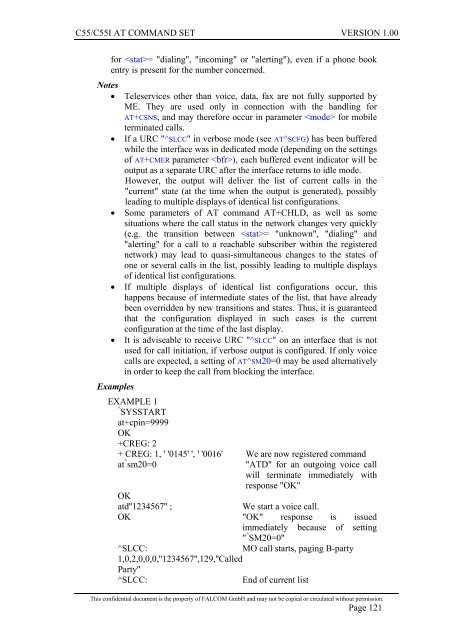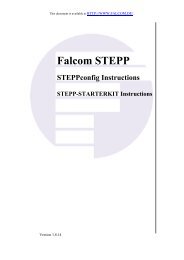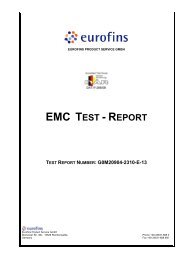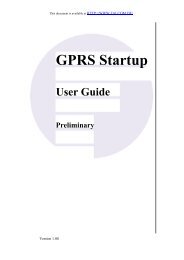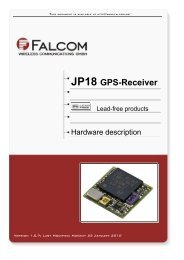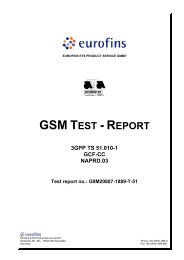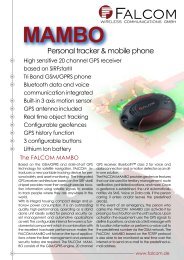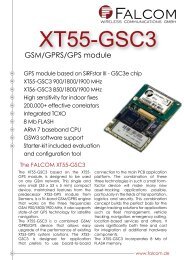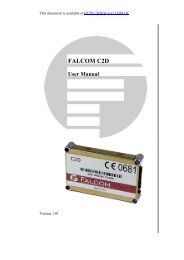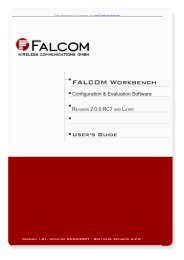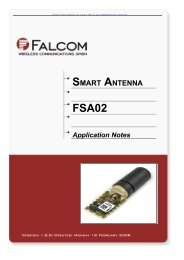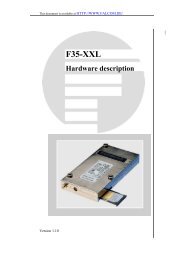C55/C55i AT COMMAND SET Description Preliminary - Falcom
C55/C55i AT COMMAND SET Description Preliminary - Falcom
C55/C55i AT COMMAND SET Description Preliminary - Falcom
Create successful ePaper yourself
Turn your PDF publications into a flip-book with our unique Google optimized e-Paper software.
<strong>C55</strong>/<strong>C55</strong>I <strong>AT</strong> <strong>COMMAND</strong> <strong>SET</strong> VERSION 1.00<br />
for = "dialing", "incoming" or "alerting"), even if a phone book<br />
entry is present for the number concerned.<br />
Notes<br />
• Teleservices other than voice, data, fax are not fully supported by<br />
ME. They are used only in connection with the handling for<br />
<strong>AT</strong>+CSNS, and may therefore occur in parameter for mobile<br />
terminated calls.<br />
• If a URC "^SLCC" in verbose mode (see <strong>AT</strong>^SCFG) has been buffered<br />
while the interface was in dedicated mode (depending on the settings<br />
of <strong>AT</strong>+CMER parameter ), each buffered event indicator will be<br />
output as a separate URC after the interface returns to idle mode.<br />
However, the output will deliver the list of current calls in the<br />
"current" state (at the time when the output is generated), possibly<br />
leading to multiple displays of identical list configurations.<br />
• Some parameters of <strong>AT</strong> command <strong>AT</strong>+CHLD, as well as some<br />
situations where the call status in the network changes very quickly<br />
(e.g. the transition between = "unknown", "dialing" and<br />
"alerting" for a call to a reachable subscriber within the registered<br />
network) may lead to quasi-simultaneous changes to the states of<br />
one or several calls in the list, possibly leading to multiple displays<br />
of identical list configurations.<br />
• If multiple displays of identical list configurations occur, this<br />
happens because of intermediate states of the list, that have already<br />
been overridden by new transitions and states. Thus, it is guaranteed<br />
that the configuration displayed in such cases is the current<br />
configuration at the time of the last display.<br />
• It is adviseable to receive URC "^SLCC" on an interface that is not<br />
used for call initiation, if verbose output is configured. If only voice<br />
calls are expected, a setting of <strong>AT</strong>^SM20=0 may be used alternatively<br />
in order to keep the call from blocking the interface.<br />
Examples<br />
EXAMPLE 1<br />
^<br />
SYSSTART<br />
at+cpin=9999<br />
OK<br />
+CREG: 2<br />
+ CREG: 1, ' '0145' ', ' '0016' We are now registered command<br />
^<br />
at sm20=0 "<strong>AT</strong>D" for an outgoing voice call<br />
will terminate immediately with<br />
response "OK"<br />
OK<br />
atd''1234567'' ; We start a voice call.<br />
OK "OK" response is issued<br />
immediately because of setting<br />
^<br />
" SM20=0"<br />
^SLCC: MO call starts, paging B-party<br />
1,0,2,0,0,0,''1234567'',129,''Called<br />
Party''<br />
^SLCC: End of current list<br />
This confidential document is the property of FALCOM GmbH and may not be copied or circulated without permission.<br />
Page 121


